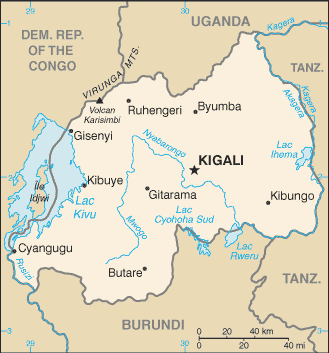 |
usa | world | animals | vocabulary | health | science | math | history |
Rwanda
Map Courtesy CIA World Factbook
Prior to European colonization, Rwanda was the site of one of the region's most complex monarchical systems. The earliest known inhabitants of the region now known as Rwanda were the Pygmy and Twa. Later, groups known as Hutus and Tutsis also settled in the same region. In 1895 Rwanda, like Burundi, became a German province. The Germans, however, were at first completely dependent on the existing government. The German authority kept the indigenous administration system by applying the same type of indirect rule established by the British Empire in the Ugandan kingdoms. After Germany's loss in World War I, the protectorate was taken over by Belgium with a League of Nations mandate. Belgian rule in the region was far more direct and harsh than that of the Germans. Belgian colonizers, backed by Christian churches, mainly Catholics, used the Tutsi upper class over lower classes of Tutsis and Hutus, creating a wider social gap between social entities than had existed before. Belgian forced labor policies and stringent taxes were mainly enforced by the Tutsi upper class, who the Belgians used as buffers against people's anger, thus further polarising the Hutu and the Tutsi. Many young peasants, in order to escape tax harassment and hunger, migrated to neighboring countries. They moved mainly to Congo but also to Ugandan plantations, looking for work. After World War II Rwanda became a UN trust territory with Belgium as the administrative authority. Through a series of processes, including several reforms, the assassination of King Mutara III Charles in 1959 and the fleeing of the last Nyiginya clan monarch, King Kigeri V, to Uganda, the Hutu gradually gained more and more power until, upon Rwanda's independence in 1962, the Hutu held virtually all power. In 1990, the Tutsi-dominated Rwandese Patriotic Front (RPF) launched military attacks against the Hutu government of Rwanda from their base in Uganda. The military government of Juvénal Habyarimana responded with pogroms against Tutsis, whom it claimed were trying to re-enslave the Hutus. Fighting continued until 1992, when the government and the RPF signed a cease-fire agreement known as the Arusha accords in Arusha, Tanzania. In 1994, President Habyarimana was assassinated when his Falcon 50 trijet was shot down while landing in Kigali. It is remains unclear who was responsible for the assassination – most credible sources point to the presidential guard, spurred by Hutu nationalists fearful of losing power, although others believe that Tutsi rebels were responsible. Over the next three months, the military and militia groups killed approximately 800,000 Tutsis and Hutu moderates in the Rwandan Genocide. The RPF launched attacks, and occupied the northern, the east and the southern parts of the country by June. On the 4th of July, the war ended as the RPF entered the capital Kigali while French peacekeeper troops were occupying the south-west part of the country under Opération Turquoise. Over 2 million Hutus fled the country after the war, fearing Tutsi retribution. Most have since returned, although some militias remain in the Democratic Republic of the Congo, and have become involved in that country's civil war.
|
|||||||
 Rwanda is a small landlocked country in the Great Lakes region of central Africa. It is bordered by Uganda, Burundi, the Democratic Republic of the Congo and Tanzania. Its fertile and hilly terrain, which give it the title "Land of a Thousand Hills", supports one of the densest populations in Africa. It is best known to the outside world for the 1994 Rwandan genocide that resulted in the deaths of up to one million people.
Rwanda is a small landlocked country in the Great Lakes region of central Africa. It is bordered by Uganda, Burundi, the Democratic Republic of the Congo and Tanzania. Its fertile and hilly terrain, which give it the title "Land of a Thousand Hills", supports one of the densest populations in Africa. It is best known to the outside world for the 1994 Rwandan genocide that resulted in the deaths of up to one million people.